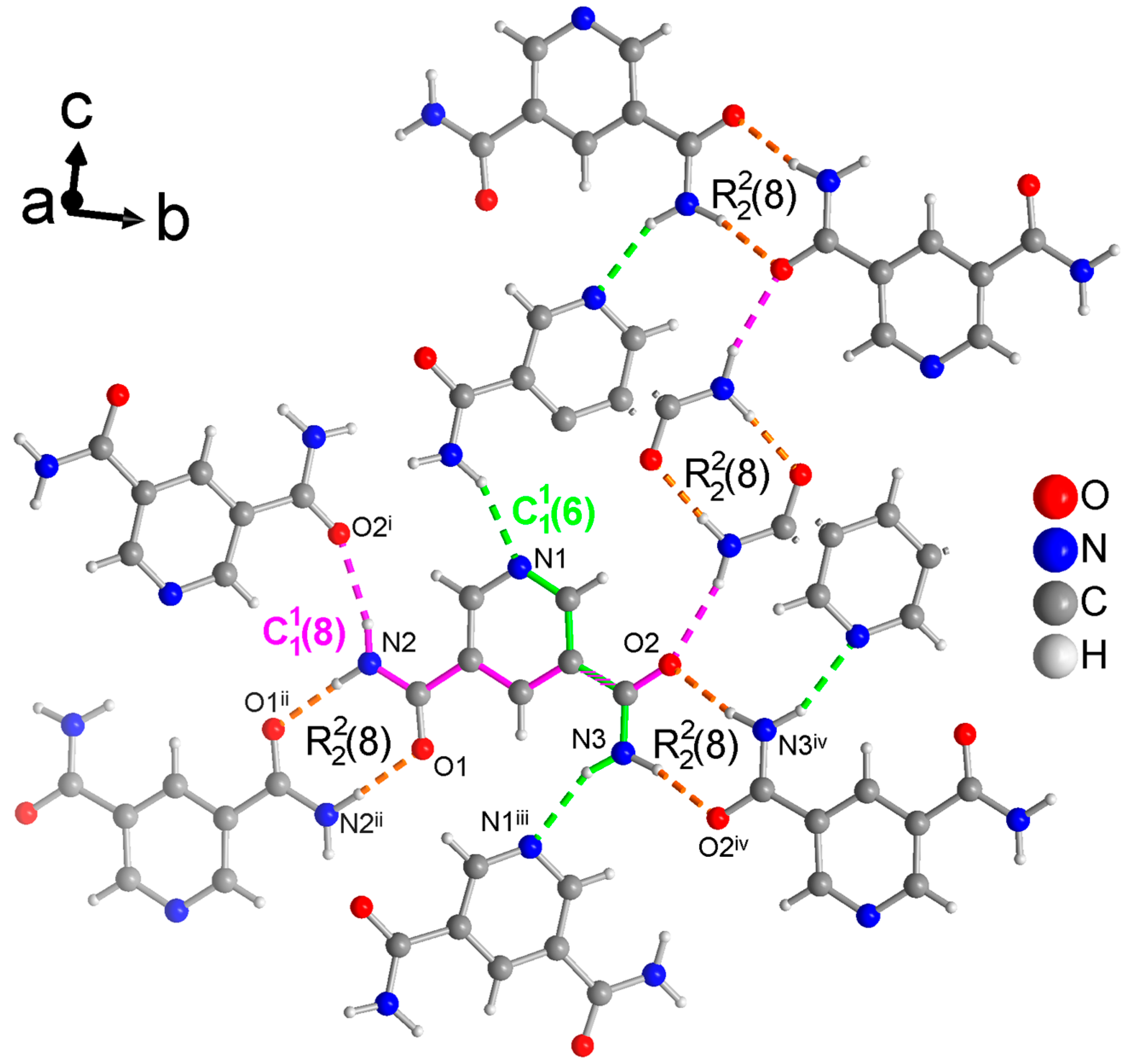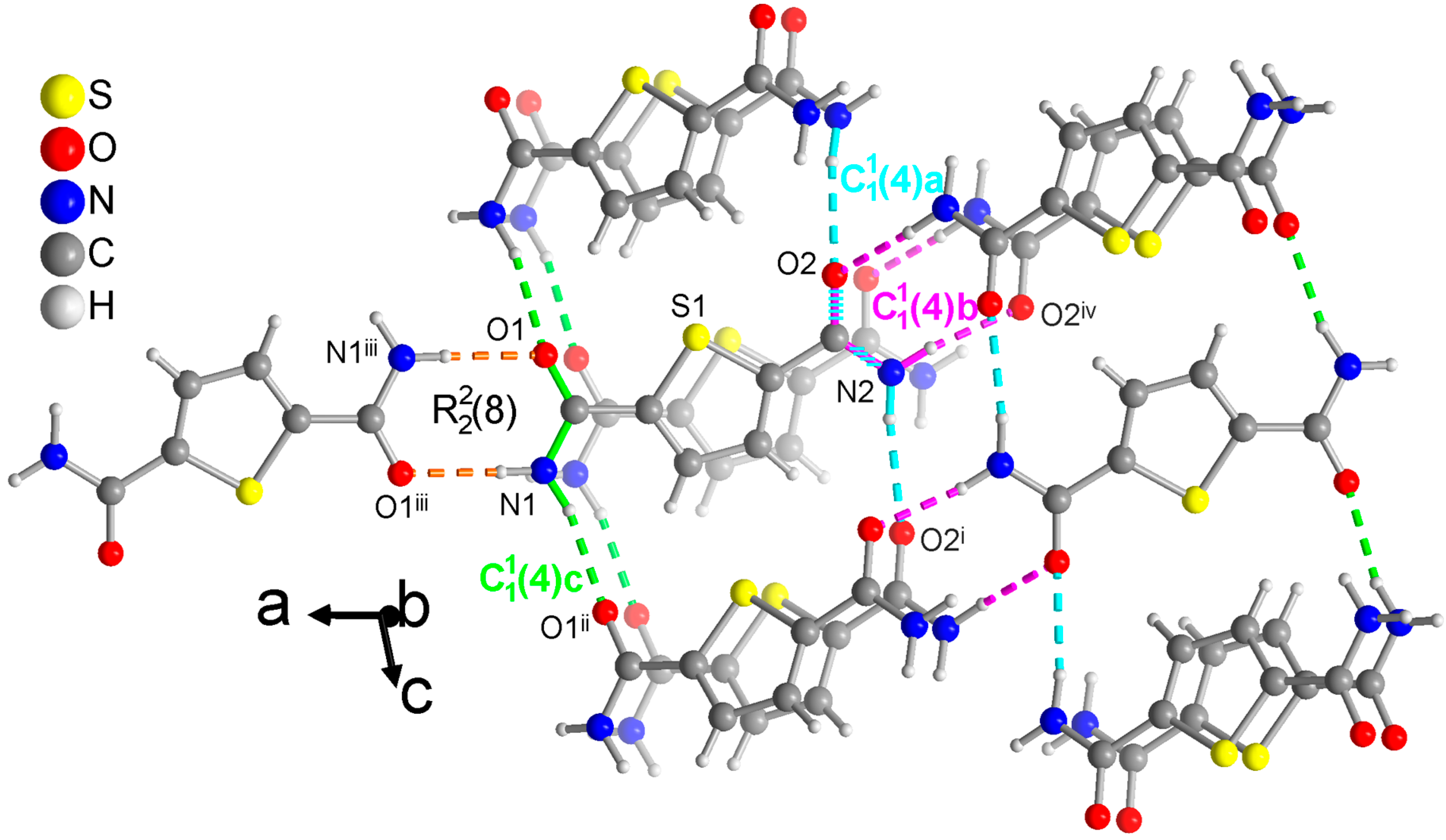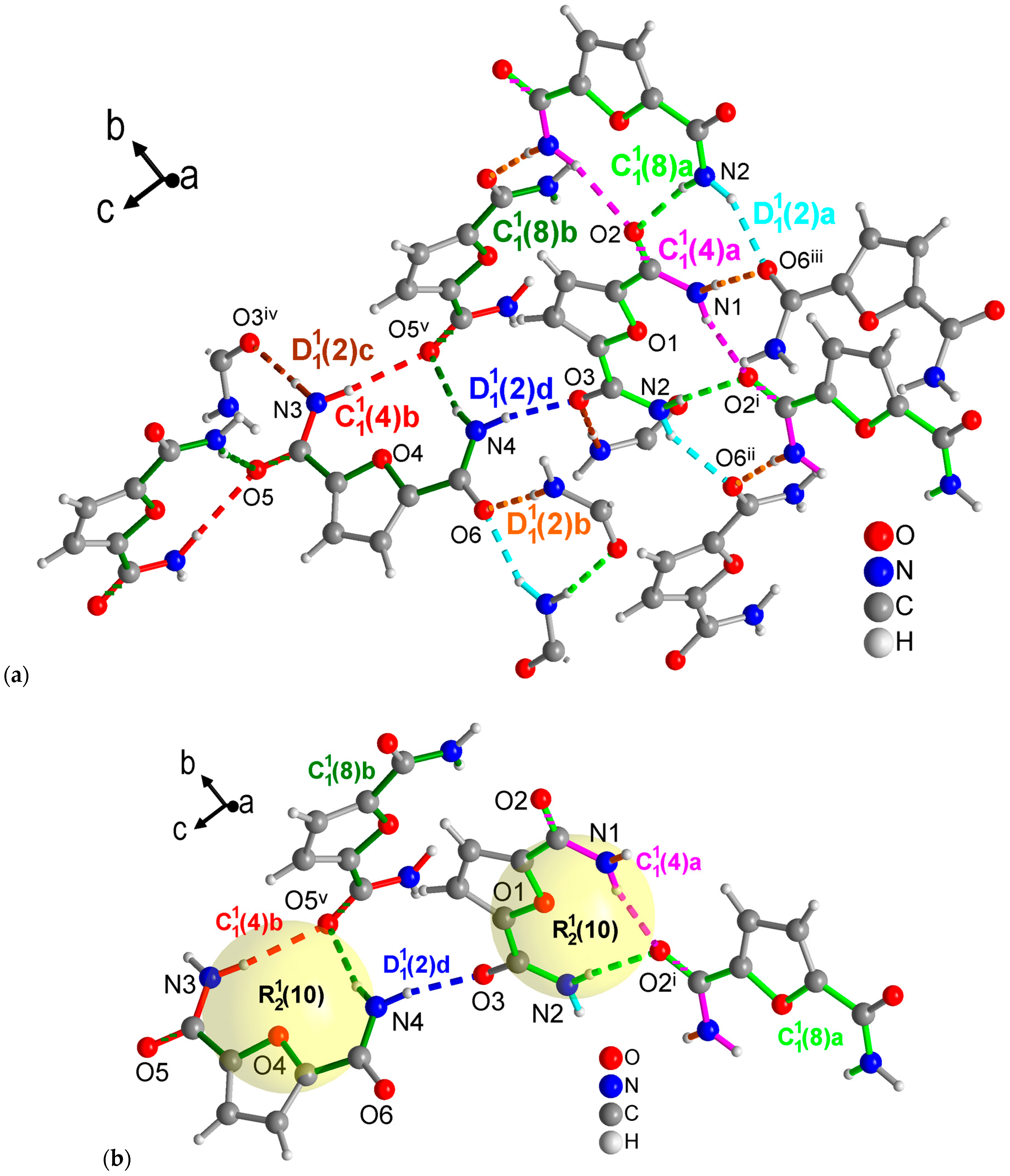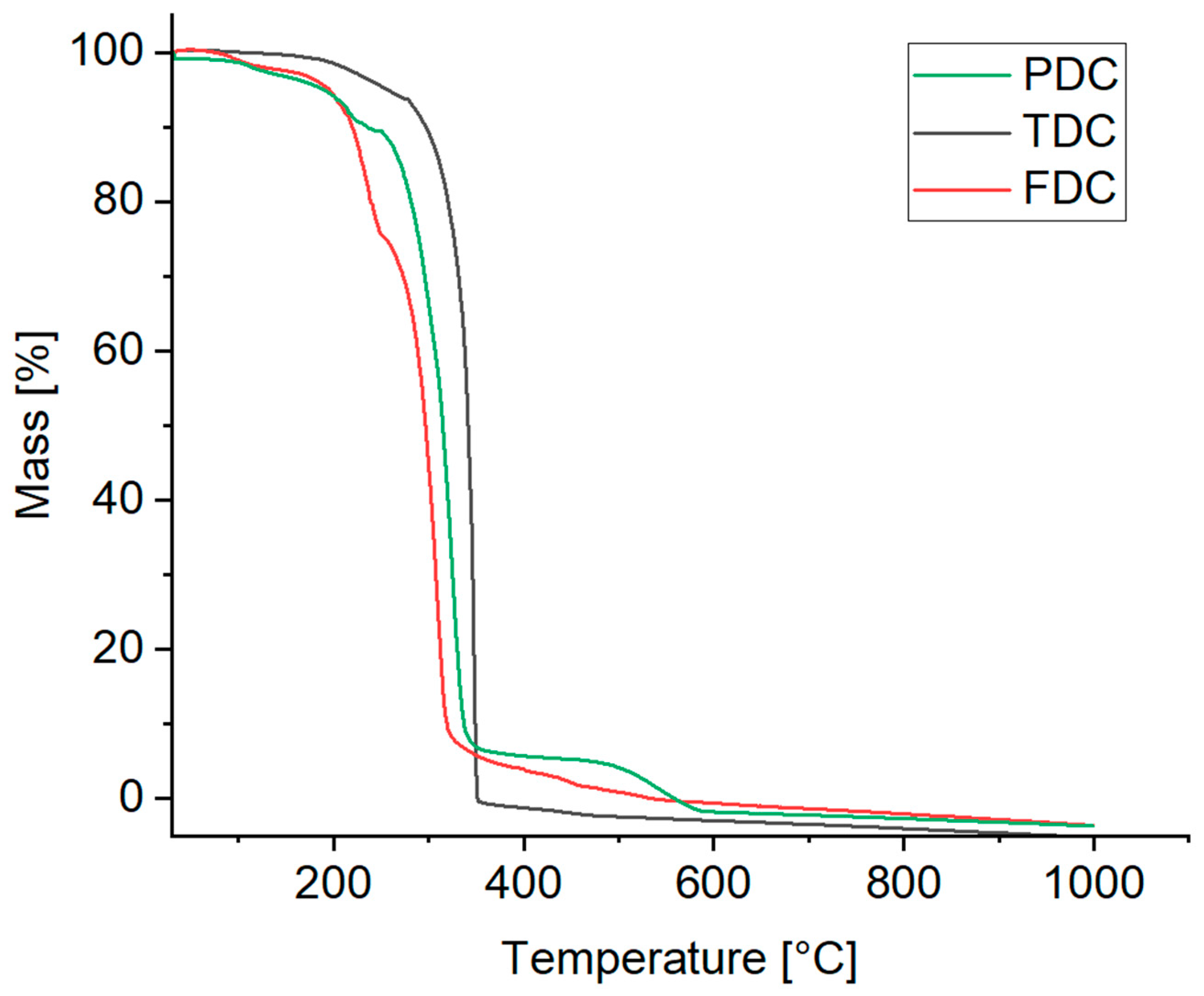Single-Crystal Structure Analysis of Dicarboxamides: Impact of Heteroatoms on Hydrogen Bonding of Carboxamide Groups
Abstract
1. Introduction
2. Materials and Methods
Synthesis of the Dicarboxamides
3. Results and Discussion
3.1. Crystal Structures of the Dicarboxamides PDC, TDC, FDC-Solv and FDC-Subl
3.2. Intermolecular Strong Hydrogen-Bonding Interactions of the Dicarboxamides
3.3. Hirshfeld Analysis
3.4. Thermogravimetric Analysis
4. Conclusions
Supplementary Materials
Author Contributions
Funding
Data Availability Statement
Acknowledgments
Conflicts of Interest
References
- Sewald, N.; Jakubke, H.D. Peptides: Chemistry and Biology; Wiley-VCH: Weinheim, Germany, 2002. [Google Scholar]
- Kumari, S.; Carmona, A.V.; Tiwari, A.K.; Trippier, P.C. Amide bond bioisosteres: Strategies, synthesis, and successes. J. Med. Chem. 2020, 63, 12290–12358. [Google Scholar] [CrossRef] [PubMed]
- Johansson, A.; Kollman, P.; Rothenberg, S.; McKelvey, J. Hydrogen bonding ability of the amide group. J. Am. Chem. Soc. 1974, 96, 3794–3800. [Google Scholar] [CrossRef]
- Hutchins, K.M. Functional materials based on molecules with hydrogen-bonding ability: Applications to drug co-crystals and polymer complexes. R. Soc. Open Sci. 2018, 5, 180564. [Google Scholar] [CrossRef] [PubMed]
- Shi, J.; Xiao, Z.; Kamaly, N.; Farokhzad, O.C. Self-assembled targeted nanoparticles: Evolution of technologies and bench to bedside translation. Acc. Chem. Res. 2011, 44, 1123–1134. [Google Scholar] [CrossRef]
- Tibbitt, M.W.; Dahlman, J.E.; Langer, R. Emerging frontiers in drug delivery. J. Am. Chem. Soc. 2016, 138, 704–717. [Google Scholar] [CrossRef]
- Wang, J.; Li, Y.; Nie, G. Multifunctional biomolecule nanostructures for cancer therapy. Nat. Rev. Mater. 2021, 6, 766–783. [Google Scholar] [CrossRef]
- Panda, C.; Sarkar, A.; Gupta, S.S. Coordination chemistry of carboxamide ‘Nx’ligands to metal ions for bio-inspired catalysis. Coord. Chem. Rev. 2020, 417, 213314. [Google Scholar] [CrossRef]
- Kumar, V.; Kumar, P.; Gupta, R. Detection of Al3+ and Fe3+ ions by nitrobenzoxadiazole bearing pyridine-2, 6-dicarboxamide based chemosensors: Effect of solvents on detection. New J. Chem. 2020, 44, 13285–13294. [Google Scholar] [CrossRef]
- Rahimi, H.; Hosseinzadeh, R.; Tajbakhsh, M. A new and efficient pyridine-2,6-dicarboxamide-based fluorescent and colorimetric chemosensor for sensitive and selective recognition of Pb2+ and Cu2+. J. Photochem. Photobiol. A Chem. 2021, 407, 113049. [Google Scholar] [CrossRef]
- Geng, W.-C.; Jiang, Z.-T.; Chen, S.-L.; Guo, D.-S. Supramolecular interaction in the action of drug delivery systems. Chem. Sci. 2024, 15, 7811–7823. [Google Scholar] [CrossRef]
- Bernhard, S.; Tibbitt, M.W. Supramolecular engineering of hydrogels for drug delivery. Adv. Drug Deliv. Rev. 2021, 171, 240–256. [Google Scholar] [CrossRef]
- Deng, C.-L.; Murkli, S.L.; Isaacs, L.D. Supramolecular hosts as in vivo sequestration agents for pharmaceuticals and toxins. Chem. Soc. Rev. 2020, 49, 7516–7532. [Google Scholar] [CrossRef]
- Yan, M.; Wu, S.; Wang, Y.; Liang, M.; Wang, M.; Hu, W.; Yu, G.; Mao, Z.; Huang, F.; Zhou, J. Recent progress of supramolecular chemotherapy based on host–guest interactions. Adv. Mater. 2024, 36, 2304249. [Google Scholar] [CrossRef] [PubMed]
- Caro Garrido, C.; Vandooren, M.; Robeyns, K.; Debecker, D.P.; Luis, P.; Leyssens, T. Combining a Drug and a Nutraceutical: A New Cocrystal of Praziquantel and Curcumin. Crystals 2024, 14, 181. [Google Scholar] [CrossRef]
- Lehn, J.-M. Perspectives in chemistry—Steps towards complex matter. Angew. Chem. Int. Ed. 2013, 52, 2836–2850. [Google Scholar] [CrossRef]
- Pauling, L. The nature of the chemical bond. II. The one-electron bond and the three-electron bond. J. Am. Chem. Soc. 1931, 53, 3225–3237. [Google Scholar] [CrossRef]
- Desiraju, G.R. Supramolecular synthons in crystal engineering—A new organic synthesis. Angew. Chem. Int. Ed. 1995, 34, 2311–2327. [Google Scholar] [CrossRef]
- Steiner, T. The hydrogen bond in the solid state. Angew. Chem. Int. Ed. 2002, 41, 48–76. [Google Scholar] [CrossRef]
- Etter, M.C. Encoding and decoding hydrogen-bond patterns of organic compounds. Acc. Chem. Res. 1990, 23, 120–126. [Google Scholar] [CrossRef]
- Etter, M.C. Aggregate structures of carboxylic acids and amides. Isr. J. Chem. 1985, 25, 312–319. [Google Scholar] [CrossRef]
- Etter, M.C. Hydrogen bonds as design elements in organic chemistry. J. Phys. Chem. 1991, 95, 4601–4610. [Google Scholar] [CrossRef]
- Boeré, R.T. Hydrogen Bonds Stabilize Chloroselenite Anions: Crystal Structure of a New Salt and Donor-Acceptor Bonding to SeO2. Molecules 2023, 28, 7489. [Google Scholar] [CrossRef]
- Ejarque, D.; Calvet, T.; Font-Bardia, M.; Pons, J. Cocrystals based on 4, 4′-bipyridine: Influence of crystal packing on melting point. Crystals 2021, 11, 191. [Google Scholar] [CrossRef]
- Bojarska, J.; Łyczko, K.; Mieczkowski, A. Synthesis, Crystal Structure and Supramolecular Features of Novel 2, 4-Diaminopyrimidine Salts. Crystals 2024, 14, 133. [Google Scholar] [CrossRef]
- Bojarska, J.; Łyczko, K.; Breza, M.; Mieczkowski, A. Recurrent Supramolecular Patterns in a Series of Salts of Heterocyclic Polyamines and Heterocyclic Dicarboxylic Acids: Synthesis, Single-Crystal X-ray Structure, Hirshfeld Surface Analysis, Energy Framework, and Quantum Chemical Calculations. Crystals 2024, 14, 733. [Google Scholar] [CrossRef]
- Iwanek, E.M.; Gliński, M. Study of the Influence of the Change from Methyl to Isopropyl Substituents in 1-(2,4,6-trialkylphenyl) ethanol on the Point Group Symmetry of the 0-D Hydrogen-Bonded Moiety. Crystals 2024, 14, 642. [Google Scholar] [CrossRef]
- Baishya, T.; Dutta, K.K.; Frontera, A.; Gomila, R.M.; Barceló-Oliver, M.; Bhattacharyya, M.K. On the Importance of H-Bonding Interactions in the Enclathration of Boric Acids in Na (I) Polymers: Experimental and Theoretical Studies. Crystals 2023, 13, 895. [Google Scholar] [CrossRef]
- Bernstein, J.; Davis, R.E.; Shimoni, L.; Chang, N.-L. Patterns in hydrogen bonding: Functionality and graph-set analysis in crystals. Angew. Chem. Int. Ed. 1995, 34, 1555–1573. [Google Scholar] [CrossRef]
- Desiraju, G.R.; Steiner, T. The Weak Hydrogen Bond in Structural Chemistry and Biology; Oxford University Press: Oxford, UK, 1999. [Google Scholar]
- Leiserowitz, L.; Schmidt, G.M. Molecular packing modes. Part III. Primary amides. J. Chem. Soc. A 1969, 2372–2382. [Google Scholar] [CrossRef]
- Macrae, C.F.; Sovago, I.; Cottrell, S.J.; Galek, P.T.A.; McCabe, P.; Pidcock, E.; Platings, M.; Shields, G.P.; Stevens, J.S.; Towler, M.; et al. Mercury 4.0: From visualization to analysis, design and prediction. J. Appl. Crystallogr. 2020, 53, 226–235. [Google Scholar] [CrossRef]
- Usha, R.; Venkatesan, K. The structure of cyclopropane-1, 1-dicarboxamide. Acta Crystallogr. B. 1979, 35, 2730–2732. [Google Scholar] [CrossRef]
- Baudron, S.A.; Avarvari, N.; Batail, P.; Coulon, C.; Clérac, R.; Canadell, E.; Auban-Senzier, P. Singular Crystalline β′-Layered Topologies Directed by Ribbons of Self-Complementary Amide⋯Amide Ring Motifs in [EDT-TTF-(CONH2)2]2X (X = HSO4−, ClO4−, ReO4−, AsF6−): Coupled Activation of Ribbon Curvature, Electron Interactions, and Magnetic Susceptibility. J. Am. Chem. Soc. 2003, 125, 11583–11590. [Google Scholar] [CrossRef] [PubMed]
- Marlin, D.S.; Olmstead, M.M.; Mascharak, P.K. Extended structures controlled by intramolecular and intermolecular hydrogen bonding: A case study with pyridine-2, 6-dicarboxamide, 1, 3-benzenedicarboxamide and N, N-dimethyl-2, 6-pyridinedicarboxamide. J. Mol. Struct. 2000, 554, 211–223. [Google Scholar] [CrossRef]
- Cobbledick, R.E.; Small, R.W. The crystal structure of terephthalamide. Acta Crystallogr. B. 1972, 28, 2893–2896. [Google Scholar] [CrossRef]
- Meyer, H.; Tropsch, H. Zur Kenntnis der Polymerie bei Pyridincarbonsäurechloriden. Monatshefte Für Chem. 1914, 35, 783–784. [Google Scholar] [CrossRef][Green Version]
- Oussaid, B.; Fayet, J.-P.; Pelletier, G.; Garrigues, B. Etude De La Conformation D’oximes Thiopheniques. Bull. Soc. Chim. Belg. 1992, 101, 969–975. [Google Scholar] [CrossRef]
- Klinkhardt, A. Derivate und Zersetzungsprodukte der Schleimsäure und Dehydroschleimsäure. J. Prakt. Chem. 1882, 25, 41–59. [Google Scholar] [CrossRef]
- Meyer, H.; McArdle, P.; Erxleben, A. Sublimation–a green route to new solid-state forms. CrystEngComm 2021, 23, 5965–5975. [Google Scholar] [CrossRef]
- Salzillo, T.; Della Valle, R.G.; Venuti, E.; Brillante, A.; Siegrist, T.; Masino, M.; Mezzadri, F.; Girlando, A. Two new polymorphs of the organic semiconductor 9,10-diphenylanthracene: Raman and X-ray analysis. J. Phys. Chem. C 2016, 120, 1831–1840. [Google Scholar] [CrossRef]
- Smith, V.J.; Marais, C.G.; Suwińska, K.; Lipkowski, J.; Szumna, A.; Esterhuysen, C.; Barbour, L.J. Concomitant polymorphs of p-iso-propylcalix[4]arene. CrystEngComm 2015, 17, 5129–5133. [Google Scholar] [CrossRef]
- CrysAlisPro. Rigaku Oxford Diffraction; Release 1.171.40.103a; Agilent Technologies Ltd.: Yarnton, UK, 2014; Available online: https://scholar.google.com/scholar_lookup?title=Rigaku+Oxford+Diffraction&author=CrysAlisPro&publication_year=2014 (accessed on 30 July 2024).
- Dolomanov, O.V.; Bourhis, L.J.; Gildea, R.J.; Howard, J.A.K.; Puschmann, H. OLEX2: A complete structure solution, refinement and analysis program. J. Appl. Crystallogr. 2009, 42, 339–341. [Google Scholar] [CrossRef]
- Sheldrick, G.M. SHELXT—Integrated space-group and crystal-structure determination. Acta Crystallogr. A 2015, 71, 3–8. [Google Scholar] [CrossRef] [PubMed]
- Sheldrick, G.M. Crystal structure refinement with SHELXL. Acta Crystallogr. C 2015, 71, 3–8. [Google Scholar] [CrossRef] [PubMed]
- Brandenburg, K. Diamond, Version 5.0.0; Crystal and Molecular Structure Visualization, Crystal Impact; K. Brandenburg & H. Putz Gbr: Bonn, Germany, 2023. [Google Scholar]
- Lu, T.; Chen, F. Multiwfn: A multifunctional wavefunction analyzer. J. Comput. Chem. 2012, 33, 580–592. [Google Scholar] [CrossRef]
- Frisch, M.J.; Trucks, G.W.; Schlegel, H.B.; Scuseria, G.E.; Robb, M.A.; Cheeseman, J.R.; Scalmani, G.; Barone, V.; Petersson, G.A.; Nakatsuji, H.; et al. Gaussian 16, Revision C.01; Gaussian, Inc.: Wallingford, CT, USA, 2016. [Google Scholar]
- Wu, Y.Y.; Meng, M.; Wang, G.Y.; Feng, P.; Liu, C.Y. Optically probing the localized to delocalized transition in Mo2–Mo2 mixed-valence systems. Chem. Commun. 2017, 53, 3030–3033. [Google Scholar] [CrossRef]
- Spackman, P.R.; Turner, M.J.; McKinnon, J.J.; Wolff, S.K.; Grimwood, D.J.; Jayatilaka, D.; Spackman, M.A. CrystalExplorer: A program for Hirshfeld surface analysis, visualization and quantitative analysis of molecular crystals. J. Appl. Crystallogr. 2021, 54, 1006–1011. [Google Scholar] [CrossRef]
- McKinnon, J.J.; Jayatilaka, D.; Spackman, M.A. Towards quantitative analysis of intermolecular interactions with Hirshfeld surfaces. Chem. Commun. 2007, 3814–3816. [Google Scholar] [CrossRef]
- Spackman, M.A.; McKinnon, J.J. Fingerprinting intermolecular interactions in molecular crystals. CrystEngComm 2002, 4, 378–392. [Google Scholar] [CrossRef]
- Petříček, V.; Dušek, M.; Palatinus, L. Crystallographic computing system JANA2006: General features. Z. Kristallogr.-Cryst. Mater. 2014, 229, 345–352. [Google Scholar] [CrossRef]











| Properties | Very Strong | Strong | Weak |
|---|---|---|---|
| Bond energy [kcal/mol] | 15–40 | 4–15 | <4 |
| D⋯A [Å] | 2.2–2.5 | 2.5–3.2 | 3.0–4.0 |
| H⋯A [Å] | 1.2–1.5 | 1.5–2.2 | 2.0–3.0 |
| D–H⋯A [°] | 175–180 | 130–180 | 90–180 |
| Compounds | Name | Graph-Set | Reference |
|---|---|---|---|
 | Cyclopropane-1,1-dicarboxamide | (6) | [33] |
 | 4,5-Dicarbamoyl-1,3-dithiol-2-one | (7) | [34] |
 | 1,3-Benzenedicarboxamide | (4) | [35] |
 | Terephthalamide | (9) (4) | [36] |
| PDC | TDC | FDC-Solv | FDC-Subl | |
|---|---|---|---|---|
| empirical formula | C7H7N3O2 | C6H6N2O2S | C6H8N2O4 | 2(C6H6N2O3) |
| mol wt (g mol–1) | 165.16 | 170.19 | 172.14 | 308.26 |
| temperature (K) | 150 | 150 | 150 | 150 |
| crystal system | monoclinic | monoclinic | monoclinic | monoclinic |
| space group | P21/n | P21/c | C2/c | P21/c |
| a (Å) | 3.7819 (1) | 18.0336 (5) | 7.4163 (1) | 13.3086 (3) |
| b (Å) | 15.3344 (7) | 3.8429 (1) | 12.8942 (2) | 10.1634 (1) |
| c (Å) | 12.1314 (5) | 10.2084 (3) | 7.8045 (1) | 10.5981 (2) |
| α (deg) | 90.00 | 90.00 | 90.00 | 90.00 |
| β (deg) | 96.023 (4) | 102.507 (3) | 96.290 (2) | 106.399 (2) |
| γ (deg) | 90.00 | 90.00 | 90.00 | 90.00 |
| Volume, V (Å3) | 699.65 (5) | 690.67 (3) | 741.83 (2) | 1375.19 (4) |
| Z, Z’ | Z = 4, Z′= 1 | Z = 4, Z′= 1 | Z = 4, Z′= 1 | Z = 8, Z′= 2 |
| Dcalc (g/cm3) | 1.568 | 1.637 | 1.541 | 1.489 |
| μ (mm–1) | 1.007 | 3.746 | 1.14 | 1.048 |
| F(000) | 344 | 352 | 360 | 640 |
| crystal size [mm3] | 0.47 × 0.09 × 0.04 | 0.34 × 0.18 × 0.08 | 0.14 × 0.05 × 0.05 | 0.09 × 0.05 × 0.04 |
| wavelength (Å) | 1.54184 | 1.54184 | 1.54184 | 1.54184 |
| No. of unique reflections | 1284 | 13,941 | 2801 | 797 |
| No. of total reflections | 6472 | 13,941 | 16,323 | 23,894 |
| No. of parameters | 125 | 117 | 231 | 68 |
| Rint | 0.0789 | - (c) | 0.0306 | 0.0376 |
| R1[F2 > 2σ(F2)] (a) | 0.0603 | 0.0548 | 0.0323 | 0.0305 |
| wR1[F2 > 2σ(F2)] (a) | 0.1585 | 0.1725 | 0.0818 | 0.0846 |
| R2, wR2(F2) [all data] (a) | 0.0669, 0.1651 | 0.0572, 0.1740 | 0.0390, 0.0858 | 0.0317, 0.0854 |
| S [all data] (a) | 1.111 | 1.148 | 1.047 | 1.081 |
| Δρmax, Δρmin (e·Å−3) (b) | 0.39, 0.44 | 0.98, −0.69 | 0.15, −0.26 | 0.19, −0.21 |
| CCDC no. | 2374614 | 2374615 | 2374616 | 2374617 |
| D—H⋯A (a) | D—H [Å] | H⋯A [Å] | D⋯A [Å] | D—H⋯A [deg] | Bond Energy [kcal/mol] |
|---|---|---|---|---|---|
| N2—H2A⋯O1 ii | 0.93 (4) | 1.88 (4) | 2.810 (2) | 177 (3) | −24 |
| N2—H2B⋯O2 i | 0.88 (4) | 2.12 (4) | 2.968 (2) | 161 (4) | −12 |
| N3—H3A⋯N1 iii | 0.93 (4) | 2.16 (4) | 3.033 (3) | 156 (3) | −16 |
| N3—H3B⋯O2 iv | 0.92 (3) | 2.08 (3) | 2.978 (2) | 165 (3) | −16 |
| D—H⋯A (a) | D—H [Å] | H⋯A [Å] | D⋯A [Å] | D—H⋯A [deg] | Bond Energy [kcal/mol] |
|---|---|---|---|---|---|
| N1—H1A⋯O1 ii | 0.89 (5) | 2.15 (5) | 3.022 (5) | 166 (4) | −12 |
| N1—H1B⋯O1 iii | 0.87 (4) | 2.08 (4) | 2.944 (4) | 172 (3) | −6 |
| N2—H2A⋯O2 i | 0.90 (7) | 2.33 (7) | 3.225 (5) | 171 (4) | −8 |
| N2—H2B⋯O2 iv | 0.93 (5) | 2.03 (5) | 2.927 (4) | 162 (4) | −15 |
| D—H⋯A (a) | D—H [Å] | H⋯A [Å] | D⋯A [Å] | D—H⋯A [deg] | Bond Energy [kcal/mol] |
|---|---|---|---|---|---|
| N1—H1A⋯O3 iv | 0.881 (16) | 2.300 (16) | 3.1799 (13) | 176.7 (14) | −16 |
| N1—H1B⋯O2 v | 0.880 (18) | 2.058 (19) | 2.9269 (14) | 169.2 (16) | −16 |
| O3—H3⋯O2 ii | 0.88 (2) | 2.10 (2) | 2.9395 (13) | 160 (2) | −14 |
| D—H⋯A (a) | D—H [Å] | H⋯A [Å] | D⋯A [Å] | D—H⋯A [deg] | Bond Energy [kcal/mol] |
|---|---|---|---|---|---|
| N1—H1A⋯O2 i | 0.895 (18) | 2.286 (18) | 3.1683 (14) | 168.3 (15) | −8 |
| N1—H1B⋯O6 iii | 0.882 (18) | 2.026 (19) | 2.9040 (14) | 173.8 (16) | −17 |
| N2—H2A⋯O6 ii | 0.914 (19) | 2.061 (18) | 2.8498 (14) | 143.7 (15) | −15 |
| N2—H2B⋯O2 i | 0.845 (18) | 2.125 (19) | 2.9545 (14) | 167.3 (16) | −14 |
| N3—H3A⋯O3 iv | 0.903 (19) | 1.974 (19) | 2.8761 (15) | 178.5 (16) | −19 |
| N3—H3B⋯O5 v | 0.904 (18) | 2.270 (19) | 3.1645 (15) | 169.8 (15) | −8 |
| N4—H4A⋯O5 v | 0.893 (19) | 2.269 (19) | 3.1433 (16) | 166.1 (16) | −9 |
| N4—H4B⋯O3 | 0.90 (2) | 1.95 (2) | 2.8406 (14) | 168.7 (18) | −18 |
| Torsion Angle [°] | ||||
|---|---|---|---|---|
| PDC | C—C—C(=O)—N3 | 7 | C—C—C(=O)—N2 | 2 |
| TDC | C—C—C(=O)—N1 | 11 | C—C—C(=O)—N2 | 8 |
| FDC-solv | C—C—C(=O)—N1 | 0.6 | ||
| FDC-subl | C—C—C(=O)—N1 | 6 | C—C—C(=O)—N2 | 3 |
| C—C—C(=O)—N3 | 3 | C—C—C(=O)—N4 | 2 | |
Disclaimer/Publisher’s Note: The statements, opinions and data contained in all publications are solely those of the individual author(s) and contributor(s) and not of MDPI and/or the editor(s). MDPI and/or the editor(s) disclaim responsibility for any injury to people or property resulting from any ideas, methods, instructions or products referred to in the content. |
© 2024 by the authors. Licensee MDPI, Basel, Switzerland. This article is an open access article distributed under the terms and conditions of the Creative Commons Attribution (CC BY) license (https://creativecommons.org/licenses/by/4.0/).
Share and Cite
Mohabbat, A.; Salama, J.; Seiffert, P.; Boldog, I.; Janiak, C. Single-Crystal Structure Analysis of Dicarboxamides: Impact of Heteroatoms on Hydrogen Bonding of Carboxamide Groups. Crystals 2024, 14, 811. https://doi.org/10.3390/cryst14090811
Mohabbat A, Salama J, Seiffert P, Boldog I, Janiak C. Single-Crystal Structure Analysis of Dicarboxamides: Impact of Heteroatoms on Hydrogen Bonding of Carboxamide Groups. Crystals. 2024; 14(9):811. https://doi.org/10.3390/cryst14090811
Chicago/Turabian StyleMohabbat, Abdulrahman, Jasmin Salama, Philipp Seiffert, István Boldog, and Christoph Janiak. 2024. "Single-Crystal Structure Analysis of Dicarboxamides: Impact of Heteroatoms on Hydrogen Bonding of Carboxamide Groups" Crystals 14, no. 9: 811. https://doi.org/10.3390/cryst14090811
APA StyleMohabbat, A., Salama, J., Seiffert, P., Boldog, I., & Janiak, C. (2024). Single-Crystal Structure Analysis of Dicarboxamides: Impact of Heteroatoms on Hydrogen Bonding of Carboxamide Groups. Crystals, 14(9), 811. https://doi.org/10.3390/cryst14090811







